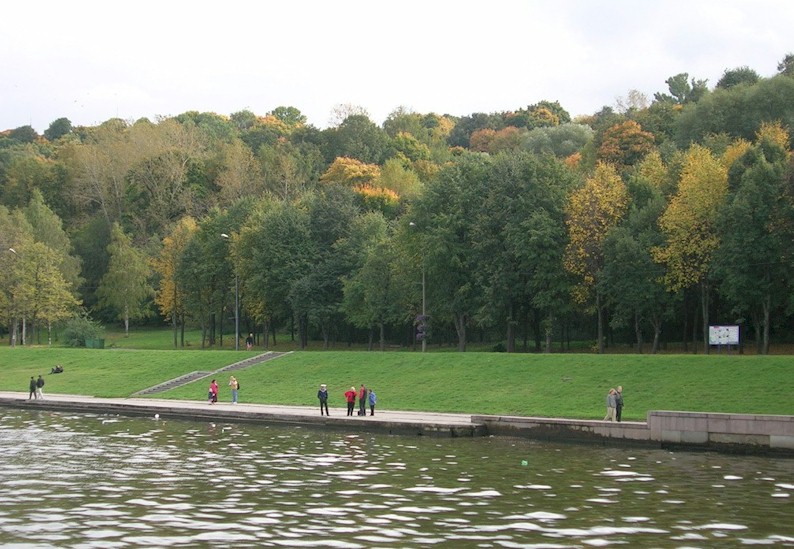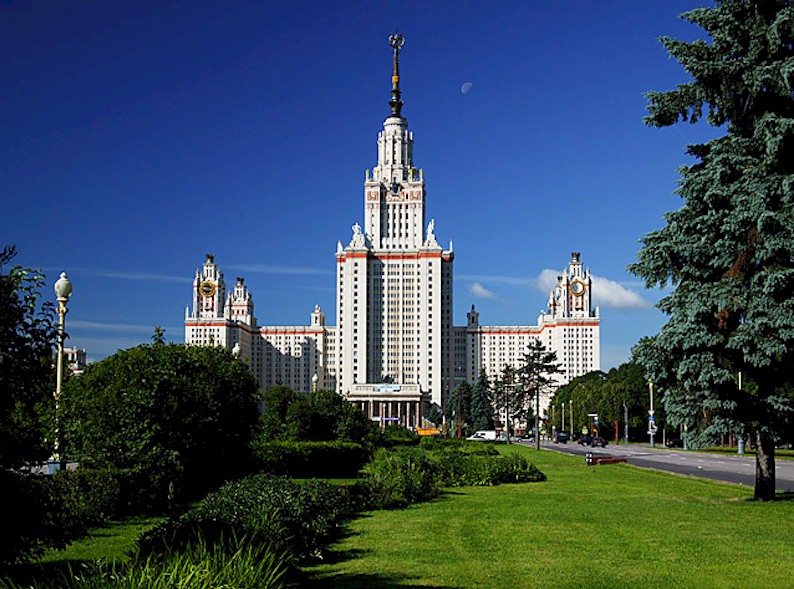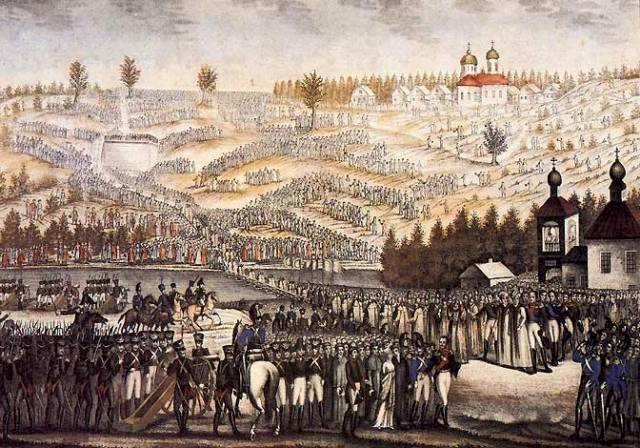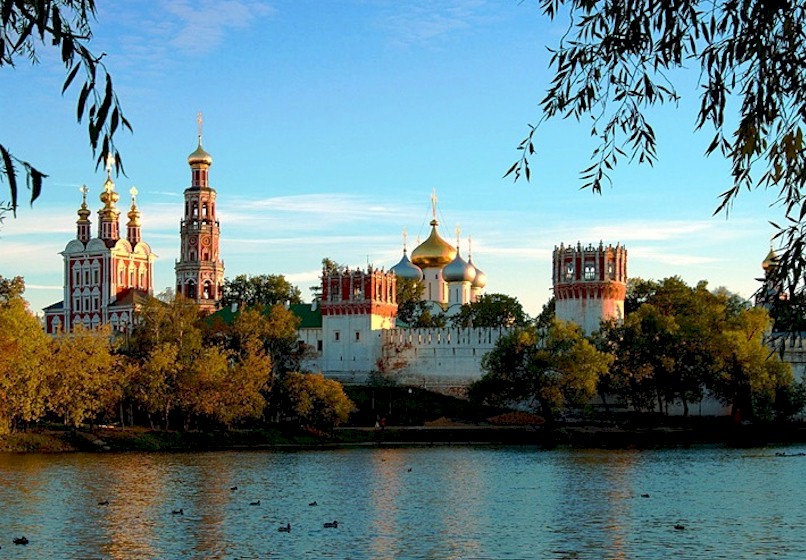Sparrow Hills
English > Locations > Locations from the novel > Sparrow Hills
Sparrow Hils
On Sparrow Hills is the last but one chapter of The Master and Margarita. From this spot, called Воробьёвы горы [Vorobyovy gory]) in Russian, Woland, Koroviev, Azazello and Behemoth said goodbye to Moscow, sitting on black horses. Together with the master and Margarita they rose into the air and galloped.
The Sparrow Hills - in reality it is only one long hill - are situated on the right bank of the Moskow River and reach a height of 220 meters above the sea level, and between 65 and 85 meters above the river level. Once, the Moscow Council for the Renovation of the City had decided to install the sculpture group which was by made the sculptor Aleksandr Yulianovich Rukavishnikov (°1950) to honour Bulgakov on Sparrow Hills, in a little park on the Moscow river, between Andreevskaya Naberezhnaya and Kosygina ulitsa. At first his monument should have been placed in the park of the Patriarch's Ponds. But the saga of those sculptures takes so long that we hardly dare to refer to them anymore.
In 1935, Sparrow Hills were renamed into Ленинские горы [Leninskye gory] or Lenin Hills. This name was kept until 1999.
The Moscow State University
In 1953, the Moscow State University - one of Joseph Stalin's so-called Seven Sisters - was built on the hills. These sisters are seven rather bombastic skyscrapers in Moscow, sometimes also called the wedding cakes because of their typical shape. The university campus is situated 220 meter above sea level and 85 meter above the river banks. The observatory with view on Moscow can be reached with a funicular.
Not far from the observatory is the well known Metromost, a metro station on a bridge over the river. This bridge, connecting Komsomolsky Prospekt to Vernadsky Prospekt, has two levels: one for car traffic, and one for the metro. The metro station Vorobyovye Gory with his wall of glass is situated at the lower level.
The cathedral of Christ the Saviour
Originally, the building of the famous Moscow Cathedral of Christ the Saviour was planned on Sparrow Hills. Tsar Alexander I (1777-1825) had promised to build it on the spot where the wooden Vorobyoy palace was destroyed in 1812 after the great fire that forced Napoleon Bonaparte (1769-1821) to withdraw from Moscow. The plans for a neoclassical design with a lot of Masonic symbols were made by architect Aleksander Lavrentevich Witberg (1787-1855) or Carl Magnus Witberg - he was of Swedish descent - but it turned out to be impossible to build the cathedral on the planned spot.
In 1817, the first stone for the Cathedral of Christ the Saviour was laid on Sparrow Hills. The Cathedral was planned to be built on the top, and to descend to the Moskow River via three terraces. But during the ground works it appeared that the mountain began to crumble and slide down, and in 1827 the construction was stopped. Twelve years later, in 1839, the construction of the Cathedral was resumed on a spot closer to the Kremlin, and to a design by architect Konstantin Andreevich Thon (1794-1881).
Bulgakov referred to this failed attempt to build the cathedral on this spot when, in Chapter 31 of the novel, he described how «a huge slab of the bank sagged into the river». So it is no coincidence that he has chosen this place, where Yeshua Ha-Notsri or Christ the Saviour should have had his temple, to look over Moscow one last time.
The Novodevichy convent
Close to the Sparrow Hills is the Новодевичье кладбище [Novodevitche kladbyshche] or Novodevichy convent. The convent was founded in 1524 by великий князь [veliki knyaz] or Grand Prince of Moscow Vasily III (1479-1533) to commemorate the reconquest of Smolensk on the Lithuanians. But most of the currently existing buildings are from the 17th century. It was here that Boris Fyodorovich Godunov (1551-1605) was elected czar and Sofia Alexeevna (1657-1704), the imperious sister of czar Peter the Great (1672-1725), was imprisoned.
The Novodevichy convent has one of the most famous graveyards of Russia. party leader Nikita Sergeevich Khrushchov (1894-1971), film director Sergey Mikhailovich Eisenstein (1894-1971), former minister Vyatsheslav Mikhailovich Molotov (1890-1986), writer Anton Pavlovich Chekhov (1860-1904), aviation pioneer Andrey Nikolaevich Tupolev (1888-1972), composer Sergey Sergeevich Prokofyev (1891-1953)... and Mikhail Anasafievich Bulgakov (1891-1940) are buried here.
Bulgakov lies here with his third wife Elena Sergeevna Nyurenberg (1893-1970). When Elena Sergeevna was searching for a nice stone for the grave of Bulgakov, she found a block of granite coming from the Crimea. Later it appeared to be the tombstone of the original grave of Nikolay Vasilyevich Gogol (1809-1852).
Gogol was first buried on the cemetry of the Danilov convent, but in the early ´30's his grave was relocated to Novodevichy, together with the graves of Vladimir Vladimirovich Mayakovsky (1893-1930) en Anton Pavlovich Chekhov (1860-1904). The gravestone (with a crucifix on it) was replaced by a bust of Gogol. Bulgakov would have been honoured, for Gogol was his shining example.
With his grave on Novodevichy convent, «Булгаков оставался в Москве навсегда» or «Bulgakov stayed forever in Moscow».
Share this page |




